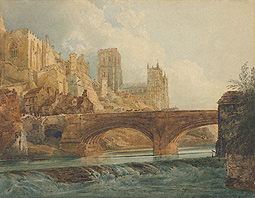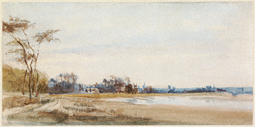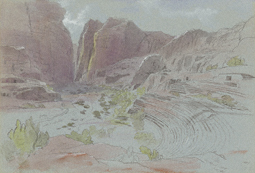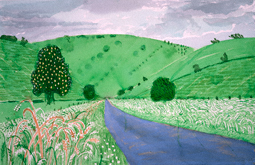 |

 |
 |
Durham Cathedral and Castle, Thomas Girtin, about 1800
|
 |
 |
|
Watercolor is regarded as one of the most challenging artistic techniques. Its liquid nature is capable of extraordinary effects of luminosity, but is often challenging for an artist to control.
This exhibition presents works of the 1700s and 1800s by some of the greatest British masters of the medium, including Thomas Gainsborough, J.M.W. Turner, and William Blake. It explores their innovative working methods, and looks at the sketching and study of the period. It includes many masterpieces that were recently acquired by the J. Paul Getty Museum in an ongoing initiative to build a representative British works-on-paper collection. Also accompanying this exhibition is an installation of three contemporary watercolors by British artist David Hockney, bringing the tradition of the watercolor into the present day.
In the image above, Thomas Girtin painted a dramatic view of a medieval cathedral and castle from the bank of the River Wear in northeastern England. He famously used a wide palette with many more tints and subtints than other artists, visible here in the range of blues and greys of the river.
|
 |
|
In the early 1700s, watercolor painting was seen as an amateur pastime unworthy of true painters. Toward the end of the century, however, British artists started to make watercolors designed to compete directly with oil paintings. They were bigger, with stronger colors and dramatic compositions.
As the craft developed a new confidence, watercolor artists felt underserved by the Royal Academy of Arts exhibitions that were dominated by oil paintings. They seceded to form their own society in 1804. The "exhibition watercolors" produced at this time attracted new audiences of collectors and produced technically complex and powerful works.
In this image, Turner displays his characteristic experimentation with techniques and materials. The tempestuous sky and gray storm clouds in the distance were created with broad applications of color over still wet areas. This is known as the "wet-on-wet" technique.
|
 |
 |

 |
 |
The Salt Marshes near Trouville, Richard Parkes Bonington, 1826
|
 |
To gather motifs and material for their work, British artists of this period often made sketching trips in Britain, throughout Europe and beyond. Equipped with sketchbooks and portable boxes containing dry cakes of watercolor pigment—and by the 1840s, moist versions and tubes—artists could conveniently capture the elements and effects of nature in color.
This work depicts a salt marsh near Trouville, a seaside resort in northwestern France. It was a beloved sketching place for many artists, including Richard Parkes Bonington, who spent most of his short career in France.
The low viewpoint emphasizes the open blue-tinged sky, and includes the calm, mirror-like water of a salt marsh. With its delicate attention to the gradations of color in the landscape, combined with use of loose brushstrokes, Bonington's work adds an important dimension to the work of British artists of the period.
|
 |

 |
 |
Petra, April 14, 1858, Edward Lear, 1858
|
 |
 |
The abandoned historic city of Petra, in present-day Jordan, was known through ancient texts, but remained unexplored by Westerners until 1812. The British traveler, topographical artist, and writer Edward Lear was an early visitor.
Shortly after his arrival there, a mob of local tribesmen sought money from Lear and roughed up members of his party. Lear was forced to leave, but made this view of the remains of an ancient theater before he did so, and recalled in his journal: "I had not long to devote to my drawing...yet how vivid and enduring are the memories of that half-hour!"
|
 |
 |

 |
 |
A Larger Valley, Millington, David Hockney, 2004. Kathi & Gary Cypres Collection.
© David Hockney. Photo: Richard Schmidt
|
 |
To accompany the exhibition is an installation of three contemporary watercolors by British artist David Hockney, who is best known for his California-based paintings and photocollages. A visit to the Yorkshire countyside of his childhood inspired him to make these colorful and personal watercolors. He compared the landscape of his mother country to the wide vistas of the American West.
In this depiction of a lush valley, Hockney paints a road curving into rolling green hills dotted with trees. His lively palette and exuberant brushstrokes add a fresh spirit to the strong tradition of British watercolors.
|
 |




